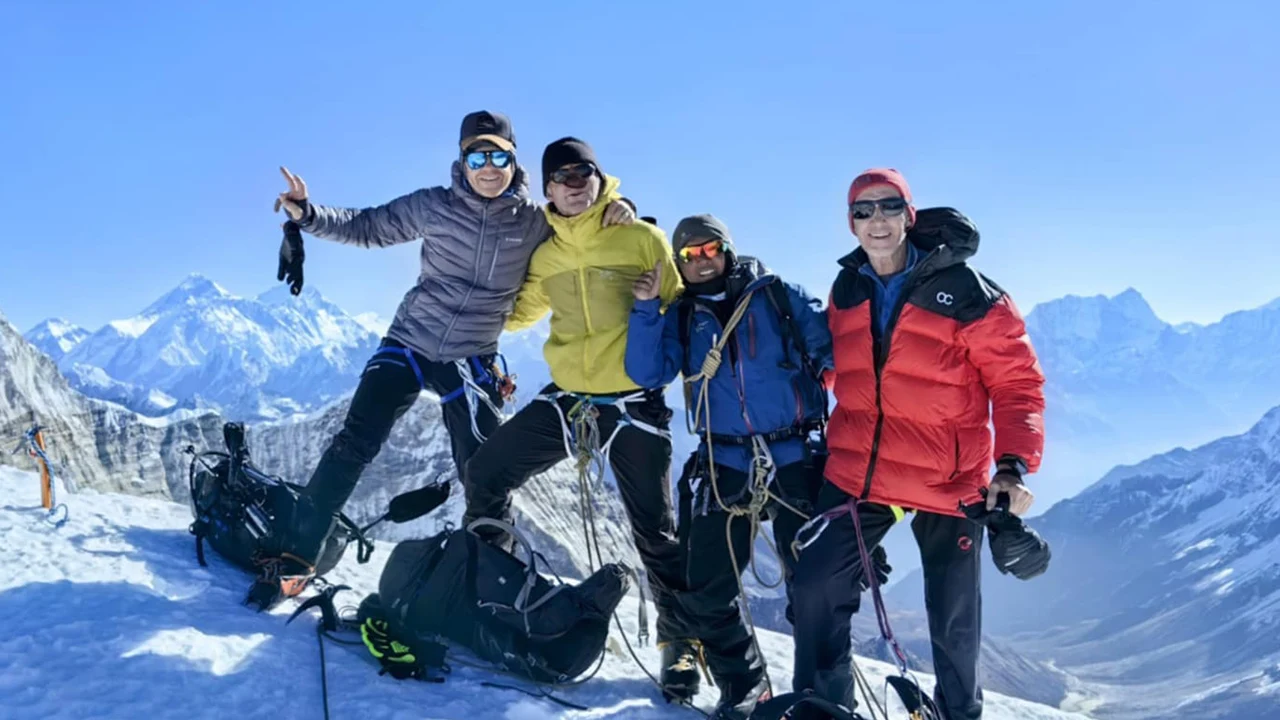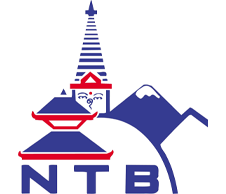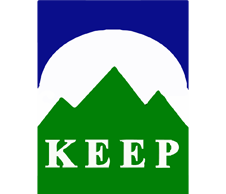Upon your arrival at Tribhuvan International Airport, our representative will greet you and transfer you to your hotel in Kathmandu. After a long journey, you may relax or explore the bustling streets of Thamel, known for its trekking shops, cafés, and cultural charm. In the evening, enjoy dinner and a trip briefing with your guide. Overnight at hotel accommodation.
Pisang Peak Climbing
Overview
Pisang Peak Climbing (6,091m) is one of the most popular trekking peaks in the Annapurna region, perfect for adventure seekers looking to combine high-altitude trekking with a thrilling Himalayan summit. This 19-day journey takes you through the legendary Annapurna Circuit trail, offering breathtaking landscapes, diverse culture, and a rewarding climbing experience.
The trip begins with a scenic drive from Kathmandu to Besisahar, followed by trekking through lush valleys, terraced fields, and traditional Gurung and Manangi villages. As you ascend higher, the landscape transforms into rugged alpine terrain, with stunning views of Annapurna II, III, IV, Gangapurna, and Lamjung Himal. The climb to Pisang Peak itself requires some basic mountaineering skills, including the use of ropes, crampons, and ice axes, making it an excellent choice for climbers with limited experience but good fitness.
Acclimatization days in Manang and the gradual ascent help prepare your body for the altitude, ensuring a safer and more enjoyable climb. The highlight of the expedition is the summit day, where you’ll stand on top of Pisang Peak, gazing at an incredible 360° panorama of the Annapurna range, Dhaulagiri, and even as far as the Tibet plateau on a clear day.
After the climb, the route continues across the iconic Thorong La Pass (5,416m), one of the highest trekking passes in the world. Descending into the Mustang region, you’ll visit Muktinath, a sacred pilgrimage site for both Hindus and Buddhists, before reaching Jomsom. From here, a short flight to Pokhara allows you to relax by Phewa Lake and soak in the charm of Nepal’s lake city before returning to Kathmandu.
This 19-day Pisang Peak adventure is a perfect blend of mountain climbing, cultural exploration, and Himalayan trekking. With professional climbing guides, well-planned acclimatization, and breathtaking landscapes at every step, Pisang Peak is an unforgettable challenge for anyone dreaming of climbing in Nepal.
Today is dedicated to final preparations. Your guide will assist with climbing permits at the Department of Tourism and help with any last-minute shopping for gear in Thamel. If time allows, you can explore cultural landmarks like Boudhanath Stupa or Pashupatinath Temple. Overnight at hotel accommodation.
A scenic drive along rivers and terraced farmland leads you west to Besisahar, the gateway of the Annapurna Circuit. The town sits in a green valley surrounded by hills and villages. Overnight in a lodge.
You continue your journey deeper into the Annapurna region, driving along rugged mountain roads and the Marsyangdi River. Dharapani offers Tibetan-style houses and mountain hospitality. Overnight in a lodge.
Your trek officially begins today. Following forest trails and suspension bridges, you gradually ascend to Chame, the district headquarters of Manang, with its hot springs and views of Lamjung Himal. Overnight in a lodge.
Rest & Acclimatization in Upper Pisang
Trek to Pisang Peak Base Camp
Trek to High Camp
A gradual climb leads to High Camp over glacial moraine and scree. Your guide will provide training on climbing equipment such as ropes, crampons, and ice axes. Overnight camping at High Camp.
Summit Pisang Peak & Return to Base Camp
Trek to Manang
Trek to Ledar
The trail ascends through alpine pastures to Yak Kharka, where yaks graze against a backdrop of snowy peaks. Overnight in a lodge.
Cross Thorong La Pass & Trek to Muktinath
Trek to Jomsom
Flight/Drive to Pokhara
A scenic mountain flight takes you to Pokhara, a lakeside city surrounded by peaks. Relax at Phewa Lake or explore caves and waterfalls. Overnight at a hotel.
Departure from Kathmandu
Cost Includes
- Airport transfers (pick-up and drop-off in a private vehicle).
- 3 nights accommodation in Kathmandu (3-star/4-star hotel) with breakfast.
- 1-night accommodation in Pokhara at a 3-star/4-star hotel with breakfast.
- Teahouse accommodation during the trek and tented camping at base camp/high camp.
- All meals (breakfast, lunch, dinner) during the trek and climbing period.
- Licensed and experienced climbing guide and trekking guide with necessary support staff (cook, porters, assistant guides).
- Climbing permits for Pisang Peak and Annapurna Conservation Area Permit (ACAP) and TIMS card.
- Domestic flight from Jomsom to Pokhara including airport taxes.
- All ground transportation as per the itinerary (private vehicle, local jeep, tourist bus).
- Standard climbing equipment (ropes, ice screws, snow bar, etc.) – company-provided.
- First aid kit with oximeter for altitude monitoring.
- Duffel bag and sleeping bag (to be returned after trip).
- Government taxes, service charges, and official paperwork.
Cost Excludes
- International flights to and from Nepal.
- Nepal visa fees (to be obtained on arrival at Kathmandu airport).
- Extra nights in Kathmandu or Pokhara due to early arrival, late departure, or domestic flight delays.
- Personal climbing gear (boots, crampons, ice axe, harness, helmet, down jacket, gloves, etc.).
- Personal expenses such as laundry, phone, Wi-Fi, hot showers, battery charging during the trek.
- Travel and mountaineering insurance (must cover high-altitude rescue and medical evacuation).
- Tips for guides, porters, and drivers.
- Any additional costs due to unforeseen circumstances (landslides, bad weather, strikes, or personal reasons).
- Meals in Kathmandu and Pokhara (except breakfasts as included).
- Alcoholic drinks, soft drinks, and snacks during the trek.
FAQs
Pisang Peak is considered a moderately challenging trekking peak in Nepal. It requires both trekking and basic mountaineering skills. The approach involves walking through the Annapurna Circuit Trail, with gradual acclimatization before attempting the summit. The final climb includes steep snow slopes, glaciers, and some technical sections where ropes, crampons, and an ice axe are necessary. If you are physically fit, have some trekking experience, and are willing to learn climbing techniques, Pisang Peak is very achievable.
The best seasons are:
-
Spring (March – May): Clear skies, stable weather, and blooming rhododendrons make it ideal.
-
Autumn (September – November): Crisp air, excellent mountain visibility, and safe climbing conditions.
Winter (December – February) and Monsoon (June – August) are not recommended, as heavy snow, avalanches, or rainfall make the climb risky.
Previous climbing experience is not mandatory, but it is highly recommended. Pisang Peak is suitable for first-time climbers who have done high-altitude treks before. During the expedition, your climbing guide will provide training on:
-
Using crampons, ropes, and ice axe
-
Walking on snow and ice
-
Safety techniques on steep slopes
If you’ve already trekked above 4,000m (such as Everest Base Camp or Annapurna Base Camp), you’ll adapt more easily.
For Pisang Peak Climbing, you will need:
-
Pisang Peak Climbing Permit issued by NMA (Nepal Mountaineering Association).
-
Annapurna Conservation Area Permit (ACAP).
-
Trekkers’ Information Management System (TIMS) card.
These permits are arranged by your trekking company, and the cost is included in the package.
Safety is the top priority. The trek follows a gradual itinerary that allows for proper acclimatization to reduce the risk of altitude sickness. A licensed climbing guide and support team will accompany you throughout, carrying first aid kits, oximeters, and emergency communication devices. In case of emergencies, helicopter evacuation can be arranged (covered by your insurance).
-
In Kathmandu and Pokhara, you’ll stay in comfortable 3-star or 4-star hotels.
-
During the trek, you’ll stay at teahouses (basic mountain lodges) with twin-sharing rooms.
-
At Base Camp and High Camp, tented camping is provided with meals prepared by the cook.
Meals include traditional Nepali food (dal bhat), noodles, soups, bread, rice, curries, and tea/coffee. Fresh and hygienic meals are served to keep you energized for climbing.
You need both trekking gear and climbing equipment, including:
-
Trekking boots, down jacket, thermal wear, sleeping bag
-
Climbing boots, crampons, harness, helmet, ice axe
-
Sunglasses, gloves, headlamp, gaiters, trekking poles
Most personal climbing gear can be rented in Kathmandu, but having your own well-fitted boots is strongly recommended.
The full trip is 19 days, which includes:
- Arrival in Kathmandu and preparation
- Trekking through the Annapurna Circuit (via Manang) for acclimatization
- Climbing Pisang Peak (1–2 days at Base Camp/High Camp)
- Trekking down to Jomsom and flying back to Pokhara
- Return to Kathmandu
This carefully designed itinerary ensures you are well acclimatized and safe before attempting the summit.
Yes, travel insurance is mandatory. Your insurance must cover:
-
High-altitude trekking and climbing (up to 6,200m)
-
Emergency helicopter evacuation
-
Medical expenses in case of illness or injury
Without proper insurance, arranging rescue at high altitude becomes very expensive and complicated.
Reaching the summit always depends on weather conditions, health, and safety. If you cannot reach the summit, you will still enjoy the trek through the Annapurna Circuit, which itself is one of the world’s best trekking routes. Your safety is more important than the summit, and the guide will make the best decision for the group.
Pisang Peak Climbing
Trekking & Hiking Adventure




